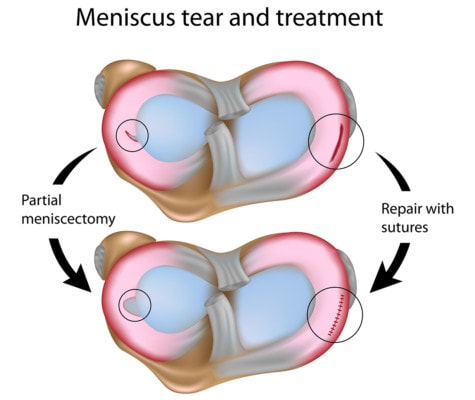Meniscus Surgery Side Effects: How Long Have We Known that Removing the Knee Meniscus was a Dumb Idea?
How long have we known about meniscus surgery side effects?
The year was 1948. Truman was the new president and the cold war was just beginning. The post WWII building and baby boom was just starting and a physician in the U.K. wrote a paper about his experience with removing the knee meniscus, which wasn’t good. Writing in the Journal of the Bone and Joint Surgery, he noted that after a number of years, 2/3’rds of his patients in which he had removed the meniscus showed x-ray evidence of arthritis. Above and below are illustrations from the original paper sent to me by a Regenexx patient.
What causes meniscus surgery side effects?
The issue is simple. The meniscus is an important shock absorber of the knee that protects the cartilage. When it tears, more than 90% of the time when knee surgery is performed, there is no repair of the meniscus tear, but instead the surgeon cuts out the torn piece. Less shock absorber means more shock gets delivered to the cartilage and bone. After awhile, this tissue reacts and cartilage is lost and the knee begins to form new bone spurs (as was documented all the way back in 1948). More modern papers have plotted the amount of increased force versus the amount of meniscus removed and that’s also not pretty. In addition, more recent papers have confirmed that removing parts of the meniscus results in more knee arthritis. So what’s the upshot? Removing any meniscus from the knee isn’t a good idea. It wasn’t a good idea in the 1940s and it’s not a good idea today. While there are a very few instances where the torn meniscus piece has to be removed surgically, the routine removal of parts and pieces of meniscus isn’t supported by any medical evidence. In fact, a recent paper has shown that meniscus surgery is not better on average then just sending the patient to physical therapy, and older studies have shown the same. The past is prologue, even for knee meniscus surgery…

Alila Medical Media/Shutterstock

If you have questions or comments about this blog post, please email us at [email protected]
NOTE: This blog post provides general information to help the reader better understand regenerative medicine, musculoskeletal health, and related subjects. All content provided in this blog, website, or any linked materials, including text, graphics, images, patient profiles, outcomes, and information, are not intended and should not be considered or used as a substitute for medical advice, diagnosis, or treatment. Please always consult with a professional and certified healthcare provider to discuss if a treatment is right for you.